Part 21
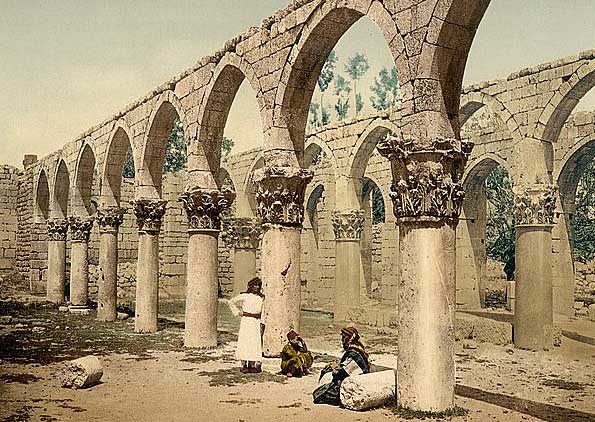
I thought of the dirges sung in synagogues commemorating our expulsion from Spain, to which we'd given so much; of the innocent left on sandbanks to drown or sold into slavery. -- Anonymous rabbi, written in Crimea circa 300 BC.
Spain is a land of incomparable climate and verdancy. If extraterrestrials with our tastes discovered this planet, they would colonize Spain as the prize jewel, the breadbasket of the world. Paleobiological evidence supports the "Out of Spain" theory for the origin of our species. Archaeological digs in caves along the coast of the North Tropics reveal the world's oldest hearths, many of which date back more than 100,000 years. Since that fateful dawn when a mutant protohuman put words to the world, Spain has been inhabited by intelligent life. Thus has it been the center of much human mythology and the source of thousands of failed religions--and a few successful ones as well.
-- An excerpt from Apollo Studies Our World by Konstantin E. Tsiolkovsky
A Million Years of Spanish History
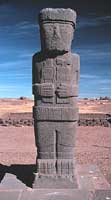
A 3,000 year old idol of Ahura Mazda, the Uncreated Creator of the religion Zoroastrianism, which enjoyed several hundred years of popularity before Buddhism drove it to decline and death. The last known Zoroastrian died in 893 AD. His son gave him a Christian burial at Barcelona.
Between 1.1 and 1 million years ago, Homo ergaster evolved as the first hominid species with reduced sexual dimorphism between males and females (males and females were now only one standard deviation in size from one another, rather than three). The shape of their skull indicated an increased capability for spatial reasoning and problem solving. Ergaster was likely the first hunting hominid, though its inability to create tools required it to pick up rocks and logs to use as makeshift weapons.
Approximately 700,000 years ago, Homo erectus evolved along the coast of the North Tropics. Sexual dimorphism increased because females had wider hips, likely to aid childbirth; it is suspected that Erectus females also had larger mammaries and greater bodyfat than Erectus males. Their skull was 75% as large as the human skull, and the shape of their cerebral cavity indicated an expansion of the visual cortex and neocortex--implying that sight and memory improved drastically. Erectus crafted the oldest known stone tools, a kind of teardrop-shaped axe, the design of which was used for hundreds of millenia, until the discovery of bronze.
Approximately 160,000 years ago, Homo sapiens idaltu arose. Their population drove Erectus out of Spain and into the wilderness that eventually became Egypt and Germany. By 70,000 years ago, H. sapiens idaltu expanded to fill the entire continent, driving Erectus to extinction. Idaltu looked like a modern human, though its brain lacked several of the expansions necessary for organizing a civilization.
100,000 years ago, a group of fishing Sapiens Idaltu were isolated from the continental population by the end of the second to last ice age. The land bridge leading from Cordoba to the isles of the North Tropics sank beneath the rising Tethys Sea. Over the next 30,000 years, these isolated hominids developed a series of mutations that led to increasingly large speech centers in the brain. This population became the reproductively distinct species, Homo sapiens. Utilizing tools, fire, and primitive boats, Sapiens abandoned the islands and recolonized the continent.
40,000 years ago, another mutation tripled the size of the speech centers in Spanish Sapiens. This new subspecies, Homo sapiens sapiens, swarmed out of the Spanish cultural hearth and drove all the other extant hominids to extinction. Though these humans covered the entire continent in less than two millenium, only in Spain did they immediately develop a protocivilization.
Approximately 10,000 years ago, the population of Spain passed the Kolikoff limit, a theoretical population density necessary for organized religion. The Buddha is born between 10,000 and 9,000 years ago. He begins the oral traditions which would become Buddhism.
7,000 years ago, animism in Spain was fully replaced by the contemplative teachings of Buddha. Approximately 6000 years ago, this religion's oral tradition passed a threshold, and it became organized.
In 4000 BC, a warming climate encouraged the foundation of Spanish civilization. Madrid was settled. In 3100 BC, Buddhism became the state religion of Spain. In 2200 BC, the Jews wrote about their escape to Spain over the Red Sea. In 2000 BC, Judaism spread from Spain to the Crimean lands near Russia. In 40 AD, a Jewish man by the name of Jesus Christ wa crucified in Barcelona. In 300 AD, the Christian Church spread back across the Red Sea to Egypt. In 1000 AD, the Spanish crown made demands from the rapidly expanding Russian Empire. In 1230 AD, the Spanish crown reasserted their demands and were denied diplomatic contact. In 1330 AD, Spain sided with China in the Russo-Chinese war and allowed Chinese troops to pass through Cordoba to Crimea. In 1390 AD, an adolescent Queen Isabella II took the Spanish throne. In 1420 AD, she sent a threatening letter to the new Tsar of Russia. In 1440 AD, she was succeeded by her daughter, Isabella III.
For two decades, Isabella III harassed the Russian borderlands near Crimea. Then the history of Spain came to a sudden and brutal end.
Buddha and Theocracy
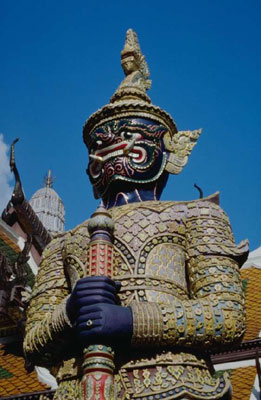
The Demon Warrior, an avatar of the Path of Blood. This figure was worshipped as an apocalyptic deity during the Russo-Spanish War.
Throughout the centuries, Buddhism has taken many forms. For the vast majority of its existence, it took the form of a series of extremely long verse-poems, which used parables to describe the lessons of the last Buddha, Siddhārtha Gautama. It taught its adherents that this world was a place of suffering, and that only by freeing ourselves from the cycle of reincarnation could we free ourselves from the horrors of this world. His methods included: meditation, living a virtuous life, and achieving purity of one's soul, body, and mind.Aside posted:
Before we begin, I'm going to tell you that the form of Buddhism I'm writing about is completely fictional. It takes the primary aim of Buddhism and twists it to a much darker, theocratic end.
The section on the Four Noble Truths is a modified version from the article on Wikipedia. To be quite honest, the article puts it so succinctly that I don't feel I can improve the description much.
To best show his original philosophy, we can look to the most ancient elements of the Buddhist tradition, the Four Noble Truths:
1. There is suffering: birth is suffering, aging is suffering, illness is suffering, death is suffering; union with what is displeasing is suffering; separation from what is pleasing is suffering; not to get what one wants is suffering; in brief, the five aggregates subject to clinging are suffering.
2. There is an origin of suffering: our craving leads to renewed existence (reincarnation).
3. Suffering may cease: if we cease to crave.
4. There is a path to the cessation of suffering, The Noble Eightfold Path: right understanding, right thought, right speech, right action, right livelihood, right effort, right mindfulness, right concentration.
As Buddhism spread to China, it's primary missionary, Thanissaro, developed a version of Buddhism which was better suited to the frontier lifestyle endured by the expanding Chinese Empire. His teachings became the tenets of Tourist Buddhism, which encourages "exploring this world to discover those places where Buddha may reveal a fragment of reality's true nature and impart his wisdom unto you."
Of course, as the Chinese empire settled, many Tourists reinterpreted Thanissaro's words as a metaphor for internal exploration, and they readopted the meditative practices of the original Buddhist faith. Nonetheless, the tradition of true Tourism continues, and even today well over a quarter million Tourists wander this world in search of hidden wisdom.

Tourists use finely crafted compasses as religious icons. They always carry a working compass or hold one while meditating.
In Spain, Buddhism took a radically different path. In 1003 AD, a Buddhist monk by the name of Sabino Arana took the head seat of the Mahabodhi, the temple built on the hill where Buddha originally attained enlightenment. He was a politically-minded man, who was well aware of the growing religious divisions between the four major Spanish provinces. Cordoba and Barcelona were decidedly Christian, while Madrid and Seville were decidedly Buddhist. Furthermore, Egypt had converted to Christianity, and the Egyptian Pharoahs continued to take an eerily close interest in the affairs of the Spanish holy land. Egyptian artists, merchants and pilgrims swarmed to Barcelona, and the city was slowly but surely becoming theirs.
Arana's response was understandable. Like a half-dozen of the monks that had preceded him, he sought a way to unify the Spanish nation and evict foreign infidels. His method was brilliant. He developed an interpretation of Buddhist dogma that supported his plans. This interpretation, now known as Steel Buddhism, reinterpreted the Buddha's desire to end suffering.
Arana told his followers that he had recieved a vision while meditating. Buddha had appeared before him and revealed two paths of unequal length: one was blinding white, and the other was boiling red. The white path was so long that Arana could not see the end. This was the Path of Peace, in which each man would achieve Enlightenment in his due time. The red path was very short. This was the Path of Blood, in which the Buddhists took up arms and spread their religion to all the nations of the world. After humanity was forced to adopt Buddhism, then the world would become conducive to achieving Enlightenment, and everyone would reach nirvana simultaneously. The cycle of suffering would end.
Buddha told Arana that he stood at a split in history: if he chose the Path of Peace, the cycle of suffering would last as long as it took a monk to destroy the Amazonia mountains by rubbing them down with a silk cloth. If he chose the Path of Blood, the cycle of suffering would peak in a thousand years and then end.
Without speaking a word, Arana made his choice. He told his followers that Buddha had transformed into a blade made of steel and manifested in Arana's hands. He demonstrated the steel sword to the monks. It was hard enough to ding an iron or bronze blade, yet flexible enough to bend and not break. Awed by the blade's seeming invincibility, the monks immediately converted to Steel Buddhism and swore to walk the Path of Blood.
From there, it's simpler to talk about how Steel Buddhism spread. Arana personally converted the royal family, while his followers rounded up irregular armies of several thousand Buddhist peasants and marched on the Christian cities in the east. At first, the Christian Spaniards refused to believe that the Buddhists were coming to conquer their loyal provinces, but in Barcelona, the Christians quickly learned their lesson. The Buddhists entered the city with swords and torches and set fire to the governor's house. They marched through the streets and rounded up anyone who lived in a home displaying a cross and slew them on the spot.
Resistance attempted to organize itself, but there was little hope. The Steel Buddhists outnumbered the city guard by an entire magnitude, and most of the native serfs and urban craftsmen were unarmed. Arana's commanders gave the Egyptians one day to flee the city. After that, anyone remaining who didn't convert to Buddhism would be killed. Many of the diehard Christians fled with the Egyptians, and after another week of religious violence, nobody in Barcelona would admit to being Christian.
Cordoba surrendered a week before the Steel Buddhists arrived. The Spanish Empire was unified. Arana was pleased, and when he retired, he felt that his life's work had been completed. The Spanish Empire would survive.
Unfortunately, he had underestimated how deeply people would believe.
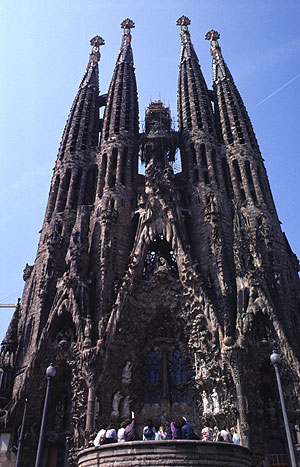
After the death of Arana, Santi Asoke, Arana's successor, ordered the construction of the Steel Temple. Though the temple was later burned, the stone skeleton still stands, looking ever more sinister with its flame-blackened decorations.
In 999 AD, a Spanish swordmaker by the name of Francisco de Quevedo found a ten meter crater in the jungle east of Cordoba. At the bottom of the crater was a twenty-three kilogram iron-nickel meteor with a 2% carbon impurity. It was a natural chunk of steel.
Most of the meteor was worthless slag, but after smelting out a steel ingot, he crafted a single dadao. Underestimating the value of such a unique metal, he sold the sword to an antique dealer for several ounces of gold. The dealer then traveled to Madrid and set up shop in the foreign quarter.
On New Years, 1000 AD, Sabino Arana went out to the foreign quarter to enjoy the sights and sounds of the city. There he met the antique dealer and watched a demonstration of the dadao's unique strength and sharpness. After haggling over the price, Arana purchased the sword on a whim and took it back to the Mahabodhi. Four years later, he used it to convince the other monks that Buddha had visited him with a vision.

Cheap reproductions of the Steel Dadao are carried by the Neo-Swordsmen, a modern descendant of Steel Buddhism. The Russian World State does not ban these weapons, but their purchase will be noted in the purchaser's individual file.
The original Steel Dadao passed from him to Santi Asoke. Santi Asoke rattled this steel, so to speak, until the Spanish Crown took an interest in his affairs.
While the Path of Blood was unifying, it was also threatening to the state. If the Buddhists dragged Spain into a war with Egypt, Germany, China, or Russia, the Spanish would inevitably lose. At the time, their comparitively small empire was technologically backwards and ill-prepared for war. King Ferdinand, ruler of the Spanish Empire between 1019 and 1057 AD, worked with some of the more politically minded monks in the Mahabodhi to overthrow Santi Asoke. Santi was poisoned, and the monks announced his successor to be King Ferdinand.
This unification of religious and secular authority is now called ruling by divine right. King Ferdinand was the first to unabashedly base his authority on religion. As head of the Steel Buddhists, he declared that "Buddhism has not attained a total grip on the men and women of this nation," and "until we are of one mind, Buddha would not wish us to fight against the vast armies of the infidels."
Steel Empire
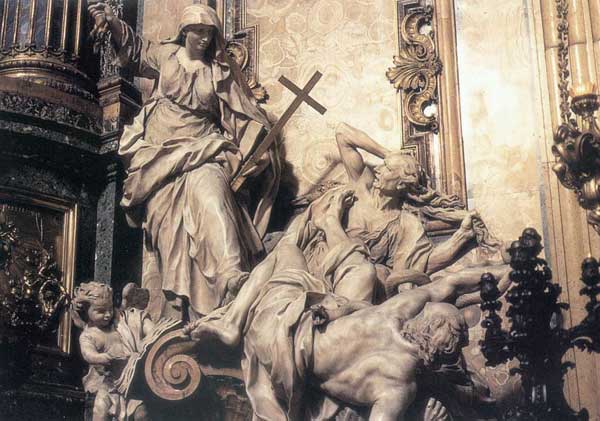
This sculpture produced in 1392 AD, "Divine Retribution," was sculpted by Don José Alvarez, an Egyptian artist and descendant of a Spanish expatriate. It depicts the Virgin Mary revealing the cross to a terrified pair: King Ferdinand (back) and Sabino Arana (forefront). Alvarez blamed these two men for the militarization of the Holy Land.
Ferdinand and his descendants worked fervently towards one end: to provide Spain with an incomparable military advantage. Unfortunately, their most advanced neighbor, Egypt, had been alienated by the conquest of Barcelona, and their second most advanced neighbor, Germany, would not easily agree to train Spanish soldiers.
Eventually, Spain had to drag itself up by its own bootsteps. By concentrating completely on military advancement, they managed to develop the protoindustrial techniques necessary to mass-cast swords and forge platemail. They modeled their military after a mixture of the Chinese and Russian methods. Like the Russians, the nobility raised and lead all the armies, but like the Chinese, most of the arming and training was mandated and paid for by the state. This model of local leadership and state training produced a superior grade of soldier, the likes of which had no match, even in the Russian Empire.
They were called Conquistadors, which meant "conqueror."
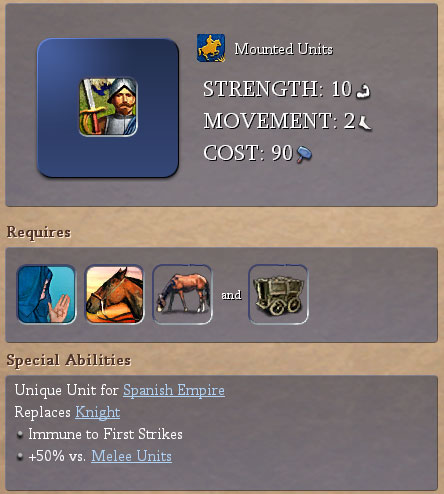
With a combined force of Conquistadors, heavily-armored pikemen, and world-class longbowmen, the Spanish military was theoretically unmatched on the battlefield. However, their commanders were not students of warfare, and they were only building a better version of the same kind of military that had won the Russo-Chinese War almost five decades before. Since then, Russia in particular had begun to find new ways to wage war.Aside posted:
Conquistadors are so much better than regular knights. In addition to the regular knight abilities, they don't lose their defensive bonuses, and they work better against melee units.
The Folly of Isabella
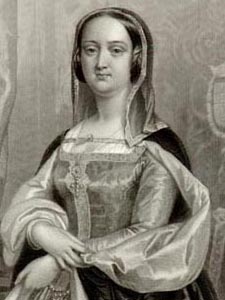
A portrait of Isabella the Angry, otherwise known as Queen Isabella I.
One of the ways that Spain dragged itself out of a technological hole was through intimidation. During the Russo-Chinese war, Tourists from the China came and asked Spain to supply whatever aid they could. In exchange, they promised to deliver all of their engineering, logistic and armorcrafting secrets to Spain. Queen Isabella offered the aid of a thousand pikemen, free passage through Cordoba from Saxon to Crimea, and diplomatic pressure against the Russians.
Isabella sent a diplomat to Russia and threatened the Tsar. She said that she would join the war unless, "Russia paid for its crimes against Buddhism," by either ending its war on the Chinese or training Buddhist craftsmen in the production of armor plating.
The Tsar was offended and cut off diplomatic contact. Isabella had expected as much. She returned to the Chinese and told them that "by associating with Tourists, I am drawing the dangerous attention of the bear." She claimed that it was in her best interests to capture the Chinese in Cordoba and turn them over to the Russians, "in order to regain the favor of mighty Russia." She asked the Chinese, what will you do to keep my loyalty?
The Chinese attempted to move their raiders out of Cordoba, but when they organized outside of the city, they were met by a line of Steel Buddhist pikemen. They were trapped. By simple mathematics, any attempt to retreat would lead to the annihilation of the precious Chinese forces, most of which were destined to fight (and eventually die) near the Crimean iron deposits. They surrendered to Isabella's will, and a new deal was hatched: Isabella would not have to supply any soldiers, and China would give her all of the secrets they had gleaned from the Russians concerning craft-guilds, metallurgy and platemail. In exchange, China would still be allowed to pass through Spain on the way to Crimea. They would recieve no other aid.
All this knowledge she took from the Chinese eventually lead to the creation of smithing guilds, most of which specialized in swords, armor, and platemail. These guilds made the Conquistador possible. However, the very first step Isabella had taken--threatening the Russians--was not easily forgotten.
Though the liberal revolution would distract the Russians for a time, they would eventually act upon the percieved Spanish aggression.
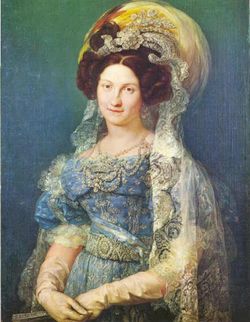
Queen Isabella II, sometimes called Isabella the Prideful.
Isabella's daughter eventually ascended to the throne. Spain's crown could pass to any child of the royal line, male or female, as long as they were a direct descendent.
Unlike her mother, Isabella II was a fervent Steel Buddhist. As she grew into the crown, she became frustrated with the increasingly complacent attitude of the Spanish people. They had prepared for war for 300 years, and yet they had never actually fought. Only 700 years remained before the world had to be united, yet it seemed as if the Russians were growing too powerful to handle in ten thousand years. In effect, she believed that her people were abandoning the Path of Blood.
The worst insult of all was the conquest of the Tourists. She felt they deserved their fate--"the Tourists were foolish pacifists"--but they were adherents of Buddha's wisdom, and of all the people in the world, they should have been united with Spain. Nevertheless, the Russians had not only conquered them but were seeding their territory with Russian immigrants. It wasn't hard to imagine that in the near future, the Tourists would become a permanent part of the monolithic Russian Empire.
She often fantasized with her advisors about waging a war against Russia. However, she was not a fool. She knew that her armies were still insufficient. Only once did she ever threaten the Russians: she wrote a vague letter to Tsar Casimir Kavkaz, implying that Spain would someday strike at the Russians.
She hardly understood the import of what she had done. Tsar Casimir was a brilliant leader with an eye for the future. He foresaw that if Russia did not develop new weapons, then the Russians would have to fight Spain's superior military forces on even ground. Hence, he reinvested much of the crown's taxes into the development of a new kind of weapon, one capable of revolutionizing the battlefield, even though that weapon wouldn't be invented until he was long dead.
Casimir Kavkaz invested in Archimedes's gonnepowder.
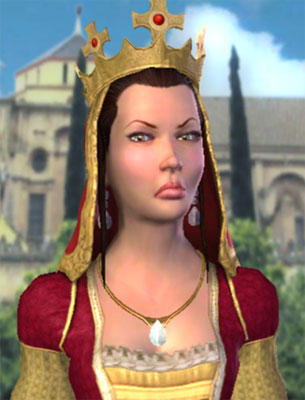
Isabella III, the last Queen of Spain.
Isabella III was a child of dogma. Her mother had raised her on a daily regimen of impotent rage, anti-Russian rhetoric, and Steel Buddhism. As a child, she could never understand why her mother could feel such hate and still restrain herself. Why did she not round up the soldiers that paraded around the palace and attack the vile Russians? She had been taught that the Spanish had the best military on the planet, so why not use it?
Isabella III was a great fan of fire and blood. She hired storytellers to craft tales of Spanish wars and Steel Buddhist victories. She immersed herself in a daily fantasy that she would lead her soldiers to such a war, to such a victory.
In short, she was high on a flight of fancy when she met General Christopher Magnain. He was the son of a Buddhist noble. He had no actual goals or aspirations and a lot of wealth. He was considered unintelligent by most of his peers, but because of his station, he was given a cushy military position. He and Isabella III became fast friends and then lovers. They were both of a type: daydreamers with a lot of power and very little insight.
Using her position, Isabella III gave General Magnain control over twenty-thousand troops--a monstrous force by medieval standards. He returned the favor by taking her with him on his first campaign: a raid on the borderlands near Crimea.
Long ago, the Jews had fled their holy land in Spain and moved to Crimea to avoid persecution. Even during the long eras of Hindu theocracy, the Russians had treated the Jews as an essential element of society. For a time, the Jewish reputation for fiscal responsibility gave the Jewish nobles the ability to run banks and deliver loans--essential societal functions that were difficult for the government to handle. Furthermore, their contributions to the Russo-Indian war were legendary--an entire literary genre had sprung up around the Jewish Swordsmen.
So when Queen Isabella and General Magnain assaulted a Jewish settlement in the foothills northwest of Crimea, the Russians reacted. The response wasn't instant--the Russian empire was wary of further wars--but as the stories of atrocities filtered down through the populace, their hearts hardened again. They began to feel the need to protect their particular underdog, the Jewish people.
The straw that broke the camel's back was a pamphlet printed by a Jewish refugee. After twelve brutal raids on Jewish border settlements, someone had captured an image of Spain that would demonize the Steel Buddhists forever:
quote:
After my father and mother were killed by Spanish soldiers, I fled into the woods along the edge of the village and waited until nightfall. I had to bury my family, G-d rest their souls, so that I could honor them one last time for raising me in their home.
As I entered the village, I discovered that many of the corpses had been looted for body parts. I saw a boy's corpse with no nose, ears, or penis. The Spanish were taking human momentos. I met one Spanish man peeling fingers upwind from a campfire. I think he was making a necklace from the bones. I took my knife and I opened his throat. Afer he drained into the grass, I took his armor to disguise myself and searched through the streets.
I found the place where my parents should have lain, but their corpses were moved. I cried for a time, until a Spanish soldier noticed me. I stood up to leave, but he called out and waved to me, and to avoid suspicion, I grunted and followed him. He threw an arm around my shoulder and tried to comfort me with a wineskin. I took a drink, and though I wanted to spit it in his face, I swallowed the wine and smiled. He led me to a bonfire where they were burning bodies. The smell made me cringe and vomit, but my companion must have thought that I was merely sick from drinking.
My ears began to hurt. Men were hooting and clapping, and I could hear a guitar being beaten. The musician must have been struggling to overcome the tide of noise that rose and receded every few seconds. In the midst of the Spanish, there was a spectacle. With the soldier still draped over my shoulder, I approached to see what was happening.
There was a bed set before the bonfire. On it was a Spanish couple, naked, sweating from the heat, and glistening blood red in the firelight. No, they weren't just colored by the fire--they were covered in blood. The woman laughed and reached down into the shadow of the bed with a fruit knife. She pulled up a hand and singled out the ring finger.
I was horrified. I saw my family ring. The hand was my father's.
The Spanish woman cut the finger away with the knife, and with the bleeding end, she began to draw circles around her breasts. The Spanish soldiers hooted, and I could hear that some were chanting: Isabella, Isabella, Isabella.
The Queen of Spain tossed the finger into the bonfire and mounted the man. He cleaned Isabella with his tongue. This was grotesque beyond all imagination, a fragment of Hell drawn up through the Earth and embodied in the souls of these subhumans. I bowed my head so that I could hide my tears and block out the nauseating sight. My knees gave out beneath me. My companion dragged me to the edge of the crowd and left me there. I lay down with my face in the grass and tried to cover my ears. I pushed my nose into the dirt and breathed soil until my sinuses bled and I could not smell.
At some point, the spectacle ended. The soldiers ignored me, thinking I was one of their own passed out on the ground. Once they were gone, I stood up and ran away until I could no longer see the village. Then I stripped off my armor and started walking the trail towards Crimea.
I had to tell the rabbi of the horrors in the wilderness, and of the Devil's incarnation as the Queen of Spain. He told me to write my story and publish it for you. Please, pray that nobody else falls victim to the Steel Buddhists.
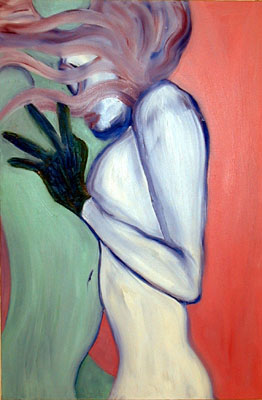
This 1922 oil on canvas was inspired by that story.
This pamphlet was entitled, The Hedonist, and soon after its publication, Russia declared war on Spain.
So far...
The war against Spain will be the next update. It should be fun.
